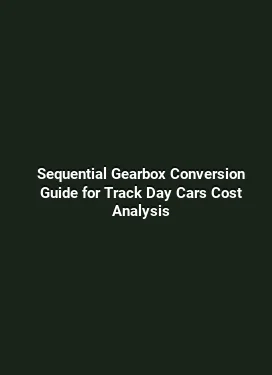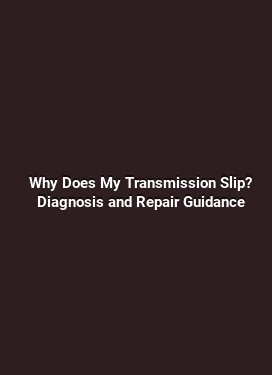Preventing Gearbox Failure: Essential Maintenance Steps to Follow
Gearbox reliability is a cornerstone of a healthy drivetrain. The gearbox, whether it’s a manual, automatic, or dual-clutch design, handles shifting, torque management, and power delivery. Proper maintenance reduces the risk of unexpected failures, minimizes downtime, and extends the life of the vehicle. This comprehensive guide dives into evidence-based maintenance practices, inspection routines, and practical tips that drivers and technicians can implement to keep the transmission system operating smoothly.
Understanding Gearbox Wear and Its Early Signs

Gearboxes are built to endure high loads, but wear accumulates over time. Common wear patterns include worn synchronizers in manual transmissions, slipping gears in automatics, and degraded clutches in dual-clutch systems. Early signs of trouble can be subtle: a delay in engagement, unusual noises during shifts, or a faint burning smell coming from the engine bay area near the transmission tunnel. Recognizing these signals promptly allows for preventative actions before minor issues escalate into major repairs.
Key factors that influence gearbox wear include operating temperature, fluid condition, torque demand, and duty cycle. Vehicles driven in urban stop-and-go traffic typically experience more frequent shifting cycles, which increases wear on components such as friction materials, seals, and bearings. On the other hand, sustained high-speed or heavy-tow conditions place greater load on gear teeth and hydraulic systems, highlighting the need for proactive checks and timely fluid changes.
Common Causes of Gearbox Wear

Understanding the primary sources of wear helps focus maintenance efforts. Excessive heat is a leading contributor, as high temperatures degrade lubricant viscosity and accelerate material fatigue. Contaminants in the fluid, such as metal particles from worn gears or dirt from degraded seals, can abrade internal surfaces and accelerate wear. Inadequate lubrication due to low or degraded transmission fluid reduces film strength, leading to scuffing and gear surface damage. Misalignment and worn bushings or bearings can cause abnormal gear engagement, clashing shifts, and unexpected noises.
Improper maintenance practices, such as irregular fluid changes or using incorrect fluid specifications, can compound wear. Additionally, failures in auxiliary systems like the cooler or the valve body can cause overheating, which compounds wear and shortens the transmission’s lifespan. Adopting a robust maintenance routine helps address these risks proactively.
Establishing a Routine: Fluid Management and Filtration
Fluid management is arguably the most impactful area for gearbox longevity. Transmission fluid performs multiple roles: it provides lubrication, acts as a hydraulic fluid for actuation, and assists in cooling. A clean, properly rated fluid helps reduce friction, dampens gear slap, and maintains smooth engagement. Fluids are formulated with viscosity ratings and additive packages tailored to specific transmission designs. Using the correct specification is essential to preserve performance and longevity.
Practical steps for effective fluid management include tracking service intervals, verifying fluid color and odor, and inspecting for fluid contamination. Dark, burnt-smelling fluid or a gritty texture indicates overheating or particulate intrusion and warrants inspection. For automated and CVT transmissions, fluid condition can directly affect shifting quality and response times. In manual gearboxes, the lubrication regime influences gear surface integrity and clutch engagement characteristics.
Filtration plays a complementary role. A healthy filtration system prevents debris from circulating through the valve body and gear mesh. For vehicles with maintenance-accessible filters, inspect and replace as recommended by the manufacturer. If a transmission has an external cooler, ensure the lines are free of kinks and leaks, and confirm proper coolant flow to prevent heat buildup in the gearbox core.
How to Assess Fluid Condition and When to Change It
Assessing fluid condition involves visual inspection and, where possible, laboratory analysis. Transmission fluid color can range from bright red to darker amber as it ages; however, color alone is not a definitive indicator of health. A thorough assessment considers smell, viscosity, and the presence of metal particles. Some workshops offer copper, iron, or aluminum particle analysis to detect wear patterns that precede failures. As a rule of thumb, adherents of the manufacturer’s recommended interval should perform changes, but driving conditions can justify more frequent changes in high-stress scenarios.
When changing fluid, follow procedure to avoid introducing air or contaminants. Warm or hot fluid drains more completely and helps remove particulates more effectively. Replace the filter if the design includes one, and ensure the gasket or seal surfaces are clean and intact to prevent leaks. For sealed or semi-sealed units, the service approach may differ; consult the vehicle’s service documentation for torque specifications and refill procedures.
Preventive Inspections: Listening for Trouble and Visual Cues
Regular inspections complement fluid changes. Visual checks can reveal early problems, such as leaks beneath the transmission, cracked hoses, or damaged wiring that affects gear actuation. Listening for unusual noises during gear engagement—rattling, grinding, or whining—can indicate bearing wear, worn synchronizers, or hydraulic pressure inconsistencies. A trained eye will correlate symptoms with scope checks to avoid unnecessary part replacements while catching developing faults early.
Core inspection areas include the transmission mount condition, oil pan integrity, and the cooler circuit. Worn or broken mounts can transmit excessive vibration to the case, accelerating wear on internal components. Inspect the cooler lines for leaks or kinks, and ensure the cooling fan engages properly at elevated engine temperatures to maintain a stable operating window for the gearbox. Additionally, the valve body and solenoids in modern automatics should be tested for proper response and pressure regulation, as faults here often manifest as harsh shifts or delayed engagement.
Checklist for a Full Regional Inspection
Develop a structured inspection routine to cover critical areas. Start with a visual sweep around the transmission housing for leaks and damage, then verify fluid level and color. Check for odor and consistency, as well as the presence of metallic debris on the magnetic drain plug. Move on to the cooler and lines to confirm unobstructed flow and no external leaks. While the engine is up, inspect the engine and transmission mounts for wear, and test drive to observe shifting behavior under varying loads and speeds. For manual transmissions, assess clutch operation and linkage alignment, noting any sticking or imprecise gear selections.
Documentation of findings is essential. Maintaining a maintenance log with dates, mileage, fluid type, and observed symptoms helps detect patterns over time and informs decisions about proactive replacements or more detailed diagnostics.
Driving Habits and Their Impact on Transmission Longevity
Driving style has a direct impact on gearbox wear. Aggressive shifting, frequent high-load starts, and heavy towing undermine the life of friction materials and gear teeth. Gentle operation, timely gear engagement, and avoiding sustained high RPMs can dramatically reduce wear. In automated transmissions, the way the accelerator pedal responds to the vehicle’s speed can influence shifting behavior and hydraulic pressure profiles. Practitioners should aim for smooth throttle modulation and predictable shifts to maintain optimal performance.
When towing or carrying heavy loads, it is beneficial to use lower gears for engine braking and to prevent excessive heat generation in the gearbox. If the vehicle’s transmission is not designed for frequent towing, consider a capacity-aware towing approach or installing additional cooling provisions as recommended by the manufacturer. Parking technique also matters: engaging parking gear and applying the parking brake helps share load across components and reduces unintended movement that could stress the drivetrain during rest.
Seasonal and Environmental Considerations
Ambient temperatures influence transmission performance. Cold starts in icy climates require gradual warming and avoidance of aggressive shifts until lubrication reaches operating temperature. High ambient temperatures, especially in the summer or in desert regions, can accelerate fluid degradation and increase cooling demands. In such conditions, monitoring fluid temperatures during operation and ensuring the cooler system remains effective are prudent steps to safeguard gearbox health.
Environmental contaminants, such as dust and road debris, can find their way into transmission housings via venting systems or seals. Regular checks of breather hoses and vent integrity help minimize pressure buildup that can lead to leaks or seal damage. Dust-laden environments may warrant more frequent fluid changes and inspections to maintain clean internal passages and valve bodies.
Diagnostics and When to Seek Professional Help
While many maintenance tasks can be performed by competent DIY enthusiasts, complex gearbox diagnostics benefit from professional equipment and expertise. Persistent symptoms such as shifting glitches, slipping during acceleration, or unexpected noises require a diagnostic approach that may include scanning for fault codes, hydraulic pressure testing, and gear lash measurements. Modern transmissions utilize robust control modules and sophisticated hydraulics; accurate interpretation of data ensures that corrective actions target the root cause rather than chasing symptoms.
Two practical diagnostic paths are worth emphasizing. First, a controlled road test that reproduces the symptom under specific conditions helps isolate whether an issue is related to hydraulics, mechanical wear, or electronic control. Second, cross-checking fluid condition and leak history with component wear tendencies can reveal if the problem stems from heat, contamination, or mechanical fatigue. Early intervention based on solid diagnostics reduces the risk of cascading failures across the drivetrain.
Preventive Upgrades and Modern Enhancements
In some cases, preventive upgrades provide meaningful returns. Upgrading cooler capacity, replacing aging seals with modern materials, or implementing enhanced filtration can extend life in harsh operating environments. For certain vehicle platforms, manufacturers offer software calibrations or adaptive shift strategies designed to reduce wear and improve efficiency. Incorporating these upgrades as part of a structured maintenance plan can yield smoother shifts, lower operating temperatures, and longer service intervals.
Real-World Scenarios: Maintenance in Action
Consider a fleet scenario where vehicles operate in a city with heavy stop-and-go traffic. Regular fluid checks every 15,000 miles, combined with a mid-life drain-and-refill and filter inspection, can prevent heat-related breakdowns. In another scenario, a sports-oriented vehicle that experiences high-speed, high-load operation benefits from a proactive cooling assessment and more frequent hydraulic system tests. Each situation benefits from a tailored maintenance plan that aligns with usage patterns and environmental conditions.
Owners who track mileage and operational history gain an empirical basis for adjusting service frequency. Data-driven maintenance reduces the likelihood of sudden failures and helps preserve resale value by maintaining a demonstrable service record. The overarching principle is to prioritize early detection, consistent care, and informed decisions based on observed performance and manufacturer guidelines.






